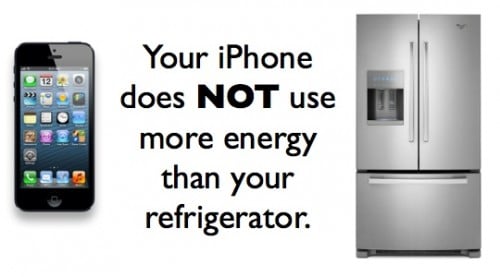Not too long ago we were marveling about how the iPhone 5 only consumed ~$0.41 per year to charge, with the conclusion that “energy consumption of a modern smartphone is minuscule”. But phone charging is only part of the picture, and as we factor in the migration to wireless networks and cloud, that smartphone uses more energy than TWO refrigerators!
The new report from IEEE Spectrum notes that all of the transitions occuring as we move from a world of desktops and landlines to a 3-screen world of laptop-tablet-smartphone require more energy.
I have seen this information twisted in the past week to say that phones use more power than household appliances. That, as noted, is silly – and the reason for the image. Even the most efficient new Energy Star large double-door fridge costs close to $100 per year in power.
So what does this data mean?
As we have moved our phones from wired landlines to wireless landlines to analog cell phones to 3G and 4G, the required infrastructure and power has exploded. Data network ranges are smaller and require more power, meaning we need more towers and transmitters to feed existing customers as they upgrade. And as more and more people buy smartphones, this means more network bandwidth and power requirements, which continue to expand the need for power.
The same is true as we have moved away from wired data connections for tablets and laptops. Our base stations and expanders at home consume considerable power, and as we move more and more of our data to Cloud storage it requires huge server farms and massive data centers – all of which means more power and infrastructure. And guess what? Cloud means wireless – so you need more wireless bandwidth and power to feed that as well!
In the end you take something that costs my family less to charge in a year than to buy a single Dunkin’ Donuts coffee – and it ends up being a huge burden on the natural resources of the world.
Here are a few more findings:
•The global ICT ecosystem uses about 1500 terawatt-hours of electricity annually, which is equal to the electricity used by Japan and Germany combined. That figure will increase as cloud architecture overtakes wired networks.
•This growth is also driven by “revolutions in everything from healthcare to cars, and from factories to farms.”
•A 50-megawatt enterprise data center in Iowa that gets 70 percent of its energy from coal and 25 percent from wind will cost $350 million less to run over its lifetime compared with one in California, with no coal in its energy mix.
•However, environmental regulations could eliminate the favored position coal enjoys because of its low cost. For instance, U.S. President Barack Obama has called for existing coal-fired power plants to meet more stringent greenhouse gas emissions standards.
•In India (the second largest mobile market after China), 75 percent of rural and 33 percent of urban cellphone base stations will need to run on alternative energy by 2020.
This holistic look at power consumption takes us out of our comfort zone – it felt a lot better thinking that whether we bought Apple or Samsung we’d be using well under $1 a year in power. However, the reality is that for all of our choices and changes there are outcomes and consequences.
